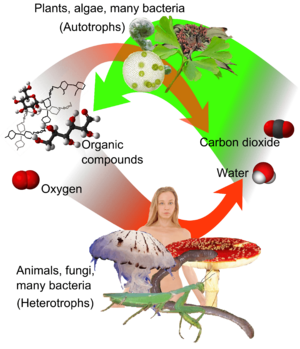Heterotroph facts for kids
A heterotroph ( from Ancient Greek [ἕτερος (héteros)] Error: {{Lang}}: text has italic markup (help), meaning 'other', and [τροφή (trophḗ)] Error: {{Lang}}: text has italic markup (help), meaning 'nutrition') is an organism that cannot produce its own food. Instead, it takes nutrition from other sources of organic carbon, mainly plant or animal matter.
The term "heterotroph" arouse in biology in 1946.
Contents
What organisms are heterotrophs?
Heterotrophs are currently found in each domain of life: Bacteria, Archaea, and Eukarya. Living organisms that are heterotrophic include all animals and fungi, some bacteria and protists, and many parasitic plants.
Most plants are autotrophs as they use light, carbon dioxide (CO2), and water to form oxygen and complex organic compounds, through the process of photosynthesis. Carnivorous plants consume animals to augment their nitrogen supply while remaining autotrophic.

Autotrophs use energy from sunlight to convert inorganic carbon dioxide to organic carbon compounds and energy to sustain their life. Comparing the two in basic terms, heterotrophs (such as animals) eat either autotrophs (such as plants) or other heterotrophs, or both.
Heterotrophs are able to use all the energy that they obtain from food for growth and reproduction, unlike autotrophs, which must use some of their energy for carbon fixation.
Types of heterotrophes
Heterotrophs may be subdivided according to their energy source. If the heterotroph uses chemical energy, it is a chemoheterotroph (e.g., humans and mushrooms). If it uses light for energy, then it is a photoheterotroph (e.g., green non-sulfur bacteria).
Heterotrophs can be organotrophs or lithotrophs. Organotrophs get energy by consuming carbohydrates, fats, and proteins from plants and animals. On the other hand, lithoheterotrophs use inorganic compounds, such as ammonium, nitrite, or sulfur, to get energy.
Flowchart
- Autotroph
- Chemoautotroph
- Photoautotroph
- Heterotroph
- Chemoheterotroph
- Photoheterotroph
In food chains
A heterotroph is known as a consumer in the food chain. Consumers are organisms that cannot make their own food supply. They use the food that producers make, or they eat other organisms. Animals are consumers. To stay alive, consumers must get food from other organisms. There are three types of consumers: Herbivores, Carnivores, and Omnivores.
Herbivores
Consumers that only eat plants are called herbivores. The word herbivore comes from the Latin words herba, which means "grass or herb," and vorare, which means "to eat." A giraffe is an example of a herbivorous consumer.
Carnivores
Consumers that only eat animals are called carnivores. The word comes from the Latin carnis, which means "flesh", and vorare, which means "to eat." A tiger is an example of a carnivorous consumer.
Omnivores
Consumers that eat both plants and animals are called omnivores. The word comes from the Latin omnis, which means "all" and vorare. Humans are a good example of an omnivorous consumer.
Related pages
See also
 In Spanish: Heterótrofo para niños
In Spanish: Heterótrofo para niños



